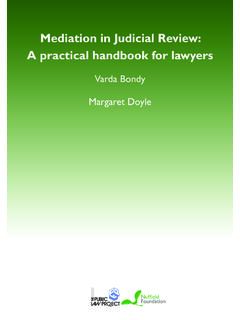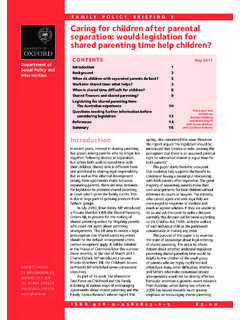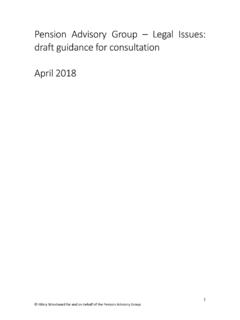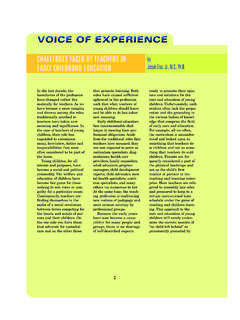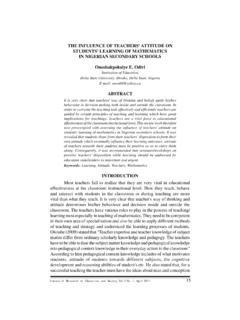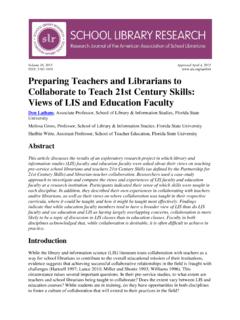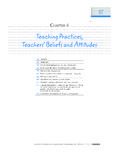Transcription of How do shortages of maths teachers affect the …
1 Allen & Sam Sims FFT Education DatalabHow do shortages of maths teachers affect the within-school allocation of maths teachers to pupils?1 About the authors Rebecca Allen is an associate research fellow at Education Datalab Sam Sims is a researcher at Education Datalab About this report This report presents the findings from the Nuffield-funded project to explore how shortages of maths teachers affect the within-in school allocation of maths teachers to pupils. It complements the Gatbsy Charitable Goundation report on the profile of the mathematics teaching workforce in the further education college sector in England (Hayward & Homer, 2015), which was itself part of a collaboration between the two Foundations. The report is available to download from About FFT Education DataLab Education Datalab produce independent, cutting-edge research that can be used by policymakers to inform education policy, and by schools to improve practice.
2 About the Nuffield Foundation The Nuffield Foundation funds research, analysis, and student programmes that advance educational opportunity and social well-being across the United Kingdom. We want to improve people s lives, and their ability to participate in society, by understanding the social and economic factors that affect their chances in life. The research we fund aims to improve the design and operation of social policy, particularly in Education, Welfare, and Justice. Our student programmes - Nuffield Research Placements and Q-Step - provide opportunities for individual students, particularly those from disadvantaged backgrounds, to develop their skills and confidence in quantitative and scientific methods. We are an independent charitable trust established in 1943 by William Morris, Lord Nuffield, the founder of Morris Motors. | @NuffieldFound Extracts from this document may be reproduced for non-commercial purposes on condition that the source is acknowledged.
3 Copyright Nuffield Foundation 2018 28 Bedford Square, London WC1B 3JS | Registered charity 206601 2 Contents Tables .. 3 Figures .. 3 Foreword .. 5 Executive Summary .. 7 1. Introduction: teacher shortages and teacher allocation .. 9 2. Data .. 10 3. Comparing the profiles of those teaching maths and English .. 11 4. Allocation of teachers across Key Stages .. 16 5. Comparing schools with differing levels of post-16 maths resit entries .. 20 6. School demographic differences in the allocation of teachers across Key Stages .. 23 7. Regional differences in the allocation of teachers across Key Stages .. 25 8. Conclusion .. 27 References .. 29 Data appendix I Local authority distribution of maths and English teachers .. 31 3 Tables Table 1: Profile of those teaching maths and English in 2016 Error! Bookmark not defined. Table 2: Career paths of those who were teaching maths and English in November 2010.
4 Error! Bookmark not Table 3: Key characteristics of those teaching maths and English at each Key 17 Table 4: Key characteristics of those teaching maths at each Key Stage in schools with low, middle and high proportions of students taking a post-16 Level 2 maths qualification .. 21 Figures Figure 1: Teaching responsibilities in 2010 of the 2016 cohort of maths and English teachers .. Error! Bookmark not defined. Figure 2: Teaching responsibilities by 2016 of the 2010 cohort of maths and English teachers .. Error! Bookmark not defined. Figure 3: Variation across schools in the proportion of inexperienced maths teachers by Key Stage .. 18 Figure 4: Variation across schools in the proportion of maths teachers with a maths degree by Key Stage .. 19 Figure 5: Variation across schools in the proportion of English teachers with an English degree by Key 20 Figure 6: Relationship between overall proportion of inexperienced maths teachers in school and teaching Key Stage 5.
5 22 Figure 7: Relationship between overall proportion without a maths degree in school and teaching Key Stage 5 .. 22 Figure 8: Percentage of inexperienced teachers in each Key Stage for maths and English, by free school meals quintile of the school .. 23 Figure 9: Percentage of teachers with a relevant degree in each Key Stage for maths and English, by free school meals quintile of the school .. 24 Figure 10: Percentage of maths and English lessons taught in each Key Stage by a teacher for whom it is their main subject .. 24 4 Figure 11: Percentage of maths and English lessons taught by inexperienced teachers across Key Stages .. 25 Figure 12: Percentage of maths and English lessons taught by out-of-subject teachers across Key Stages .. 26 Figure 13: Percentage of maths and English lessons taught by teachers for whom it is main subject, by Key Stage .. 26 Figure 14: Percentage of lessons taught by inexperienced teachers in maths (left) and English (right).
6 31 Figure 15: Percentage of lessons taught by someone without relevant academic degree in maths (left) and English (right) .. 32 5 Foreword The Nuffield Foundation has long been a champion for enabling all young people to study maths beyond the age of 16. Research we have funded has been influential both in demonstrating the comparatively low rates of participation in England, Wales, and Northern Ireland, and in developing ways to increase it. Most recently, this influence has been evident in the development of the new post-16 Core maths qualification, and in the Smith Review of post-16 mathematics. One of the most significant challenges in increasing participation is addressing the shortage of maths teachers , and we have been keen to understand more about the maths teaching workforce and issues relating to supply and retention. This report presents analysis of the ways in which schools have responded to the shortage, using the latest Schools Workforce Census (SWC).
7 The analysis presented in this report shows that in broad terms, schools deploy their more experienced maths teachers with the most relevant qualifications to teach year groups where the external stakes are high: GCSE, A-Level and GCSE retakes (Key Stages 4 and 5). This pattern is consistent across all schools, although those in disadvantaged areas are less likely to have teachers who fit this criteria, meaning that teacher shortages are having the biggest impact on pupils from disadvantaged backgrounds. This deployment of more experienced teachers at Key Stage 5, while understandable, means that the shortage of maths teachers is being felt most keenly at Key Stage 3 (and to some degree Key Stage 4). At this age, young people s attitudes to subjects and future study are crystallising. If maths teaching and learning is not as engaging or tuned to individual needs as might be desired there are significant risks of adverse effects on pupil outcomes and progression in those schools struggling to allocate specialist or experienced teachers for younger year groups.
8 We should also consider the implications of this analysis for increasing participation in post-16 maths . We welcome the government s new advanced maths premium policy, which aims to increase post-16 participation by offering financial incentives to schools. However, the potential impact on teachers should also be considered. Putting more pressure on those already teaching maths at Key Stage 5 may have implications for retaining some of the most experienced and qualified maths teachers . We would urge government, schools, and the wider education community to pay close attention to findings from the National Foundation for Educational Research study into the effect of retention and turnover on the teaching workforce. Also funded by Nuffield, several outputs from the study have already been published, showing that long working hours, increased pressure, and lack of options for part-time and flexible working are all barriers to improving teacher retention.
9 In considering the analysis presented in this report, it is important to echo the authors point about the limitations of the data it draws upon. While the SWC offers some satisfactory 6 indicators of teacher shortages in schools, it does not provide the fine-grained workforce data required to fully understand the extent of shortages , the approaches schools take to managing them, or their impact on student outcomes. This lack of adequate data means we are limited in the conclusions we can draw, but the authors make good suggestions for how we might collect more, useful data. Josh Hillman Director of Education Nuffield Foundation 7 Executive Summary There are currently well-founded concerns about maths teacher shortages in England. The economic recovery has reduced maths teacher supply as employment opportunities have improved in the private sector.
10 At the same time, demand for maths teachers has increased thanks to the requirement for all pupils without an A* C grade in GCSE maths to continue studying the qualification until the age of 18. shortages lead to disadvantaged secondary pupils having less access to experienced and well-qualified teachers (Allen & Sims, 2018). This research addresses two questions. First, how have schools responded to a shortage of maths teachers ? For example, are they using teachers who trained in other subjects to fill their staffing gaps in Key Stage 3? Second, can we use these behavioural responses as indicators of school-level maths teacher shortages . We use data from England s School Workforce Census (SWC)1 to construct a number of indicators of teacher shortages . We then compare these indicators between maths departments and English departments to investigate how maths departments have responded to shortages and to try and quantify the severity of maths teacher shortages in each school.
